
Quick Facts

Biography
Adeline Virginia Woolf (née Stephen; 25 January 1882 – 28 March 1941) was an English writer who is considered one of the foremost modernists of the twentieth century, and a pioneer in the use of stream of consciousness as a narrative device.
During the interwar period, Woolf was a significant figure in London literary society and a central figure in the influential Bloomsbury Group of intellectuals. Her best-known works include the novels Mrs Dalloway (1925), To the Lighthouse (1927) and Orlando (1928), and the book-length essay A Room of One's Own (1929), with its dictum, "A woman must have money and a room of her own if she is to write fiction."
Woolf suffered from severe bouts of mental illness throughout her life and took her own life by drowning in 1941 at the age of 59.
Biography
Early life
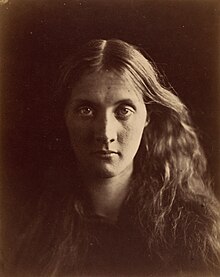
Virginia Woolf was born Adeline Virginia Stephen at 22 Hyde Park Gate in Kensington, London. Her parents were Sir Leslie Stephen (1832–1904) and Julia Prinsep Duckworth Stephen. Julia Stephen was born in British India to Dr. John and Maria Pattle Jackson. She was the great-niece of the photographer Julia Margaret Cameron and first cousin of the temperance leader Lady Henry Somerset. Julia moved to England with her mother, where she served as a model for Pre-Raphaelite painters such as Edward Burne-Jones. Julia named her daughter after the Pattle family: Adeline after Lady Henry's sister, Adeline Marie Russell, Duchess of Bedford; and Virginia, the name of yet another sister (who died young) but also of their mother, Julia's aunt.
Woolf was educated by her parents in their literate and well-connected household. Her parents had each been married previously and been widowed, and, consequently, the household contained the children of three marriages. Julia had three children by her first husband, Herbert Duckworth: George, Stella, and Gerald Duckworth. Leslie had first married Harriet Marian (Minny) Thackeray (1840–1875), the daughter of William Thackeray, and they had one daughter: Laura Makepeace Stephen, who was declared mentally disabled and lived with the family until she was institutionalised in 1891. Leslie and Julia had four children together: Vanessa Stephen (later known as Vanessa Bell) (1879), Thoby Stephen (1880), Virginia (1882), and Adrian Stephen (1883).
Sir Leslie Stephen's eminence as an editor, critic, and biographer, and his connection to William Thackeray, meant that his children were raised in an environment filled with the influences of Victorian literary society. Henry James, George Henry Lewes, and Virginia's honorary godfather, James Russell Lowell, were among the visitors to the house. Julia Stephen was equally well connected. She came from a family of beauties who left their mark on Victorian society as models for Pre-Raphaelite artists and early photographers, including her aunt Julia Margaret Cameron who was also a visitor to the Stephen household. Supplementing these influences was the immense library at the Stephens' house, from which Virginia and Vanessa were taught the classics and English literature. Unlike the girls, their brothers Adrian and Julian (Thoby) were formally educated and sent to Cambridge, a difference that Virginia would resent. The sisters did, however, benefit indirectly from their brothers' Cambridge contacts, as the boys brought their new intellectual friends home to the Stephens' drawing room.
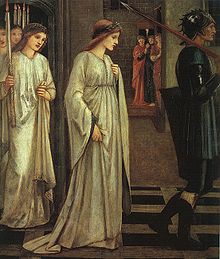
According to Woolf's memoirs, her most vivid childhood memories were not of London but of St Ives, Cornwall, where the family spent every summer until 1895. The Stephens' summer home, Talland House, looked out over Porthminster Bay, and is still standing, though somewhat altered. Memories of these family holidays and impressions of the landscape, especially the Godrevy Lighthouse, informed the fiction Woolf wrote in later years, most notably To the Lighthouse. She describes why she felt so connected to Talland House in a diary entry dated March 22nd, 1921. "Why am I so incredibly and incurably romantic about Cornwall? One’s past, I suppose; I see children running in the garden … The sound of the sea at night … almost forty years of life, all built on that, permeated by that: so much I could never explain."
The sudden death of her mother in 1895, when Virginia was thirteen, and that of her half-sister Stella two years later, led to the first of Virginia's several nervous breakdowns. After her mother and half-sister, she quickly lost her surrogate mother, Stella Duckworth, as well as her cherished brother Thoby, when he was in his mid-20s. She was, however, able to take courses of study (some at degree level) in Ancient Greek, Latin, German and history at the Ladies' Department of King's College London between 1897 and 1901. This brought her into contact with some of the early reformers of women's higher education such as the principal of the Ladies' Department, Lilian Faithfull (one of the so-called Steamboat ladies), Clara Pater and George Warr. Her sister Vanessa also studied Latin, Italian, art and architecture at King's Ladies' Department. In 2013 Woolf was honoured by her alma mater with the opening of a building named after her on Kingsway (now Kings College, London).
The death of her father in 1904 provoked her most alarming collapse and she was briefly institutionalised. She spent time recovering at her friend Violet Dickinson's house, and at her aunt Caroline's house in Cambridge. Modern scholars (including her nephew and biographer, Quentin Bell) have suggested her breakdowns and subsequent recurring depressive periods were also influenced by the sexual abuse to which she and her sister Vanessa were subjected by their half-brothers George and Gerald Duckworth (which Woolf recalls in her autobiographical essays A Sketch of the Past and 22 Hyde Park Gate).
Throughout her life, Woolf was plagued by periodic mood swings and associated illnesses. She spent three short periods in 1910, 1912 and 1913 at Burley House, 15 Cambridge Park, Twickenham, described as "a private nursing home for women with nervous disorder". Though this instability often affected her social life, her literary productivity continued with few breaks throughout her life.
Ancestry
Relatives: Sir Leslie Stephen (father); Julia Stephen (mother); Vanessa Bell (sister)
Thoby Stephen (brother); Adrian Stephen (brother); George Herbert Duckworth (maternal half-brother)
Gerald Duckworth; (maternal half-brother); Julia Margaret Cameron (great-aunt)
Lady Henry Somerset (maternal first cousin, once removed); Adeline Marie Russell, Duchess of Bedford (maternal first cousin, once removed)
| Ancestors of Virginia Woolf | ||||||||||||||||||||||||||||||||||||||||||||||||||||||||||||||||||||||||||||||||||||||||||||||||||||||||||||||||||||||||||||||||||||||||||||||||||||||||||||||||||||||||||||||||||||||||||||||||||||||||||||||||||||||||||||||||||||||||||||||||||||||||||||||||||||||||||||||||||||||||||||||||||||||||||||||||||||||||||||||||||||||||||||||||||||||||||||||||||||||||||||||||||||||||||||||||||||||||||||||||||||||||||||||||||||||||||||||||||||||||||||||||||||||||||||||||||||||||||||||||||||||||||||||||||||||||||||||||||||||||||
|---|---|---|---|---|---|---|---|---|---|---|---|---|---|---|---|---|---|---|---|---|---|---|---|---|---|---|---|---|---|---|---|---|---|---|---|---|---|---|---|---|---|---|---|---|---|---|---|---|---|---|---|---|---|---|---|---|---|---|---|---|---|---|---|---|---|---|---|---|---|---|---|---|---|---|---|---|---|---|---|---|---|---|---|---|---|---|---|---|---|---|---|---|---|---|---|---|---|---|---|---|---|---|---|---|---|---|---|---|---|---|---|---|---|---|---|---|---|---|---|---|---|---|---|---|---|---|---|---|---|---|---|---|---|---|---|---|---|---|---|---|---|---|---|---|---|---|---|---|---|---|---|---|---|---|---|---|---|---|---|---|---|---|---|---|---|---|---|---|---|---|---|---|---|---|---|---|---|---|---|---|---|---|---|---|---|---|---|---|---|---|---|---|---|---|---|---|---|---|---|---|---|---|---|---|---|---|---|---|---|---|---|---|---|---|---|---|---|---|---|---|---|---|---|---|---|---|---|---|---|---|---|---|---|---|---|---|---|---|---|---|---|---|---|---|---|---|---|---|---|---|---|---|---|---|---|---|---|---|---|---|---|---|---|---|---|---|---|---|---|---|---|---|---|---|---|---|---|---|---|---|---|---|---|---|---|---|---|---|---|---|---|---|---|---|---|---|---|---|---|---|---|---|---|---|---|---|---|---|---|---|---|---|---|---|---|---|---|---|---|---|---|---|---|---|---|---|---|---|---|---|---|---|---|---|---|---|---|---|---|---|---|---|---|---|---|---|---|---|---|---|---|---|---|---|---|---|---|---|---|---|---|---|---|---|---|---|---|---|---|---|---|---|---|---|---|---|---|---|---|---|---|---|---|---|---|---|---|---|---|---|---|---|---|---|---|---|---|---|---|---|---|---|---|---|---|---|---|---|---|---|---|---|---|---|---|---|---|---|---|---|---|---|---|---|---|---|---|---|---|---|---|---|---|---|---|---|---|---|---|---|---|---|---|---|---|---|---|---|---|---|---|---|---|---|---|---|---|---|---|---|---|---|---|---|---|---|---|---|---|---|---|---|---|---|---|---|---|---|---|---|---|---|---|---|---|---|---|---|---|---|---|---|---|---|---|---|---|---|---|---|---|---|---|---|---|---|---|---|---|---|---|---|---|---|---|---|---|---|---|---|---|---|
| ||||||||||||||||||||||||||||||||||||||||||||||||||||||||||||||||||||||||||||||||||||||||||||||||||||||||||||||||||||||||||||||||||||||||||||||||||||||||||||||||||||||||||||||||||||||||||||||||||||||||||||||||||||||||||||||||||||||||||||||||||||||||||||||||||||||||||||||||||||||||||||||||||||||||||||||||||||||||||||||||||||||||||||||||||||||||||||||||||||||||||||||||||||||||||||||||||||||||||||||||||||||||||||||||||||||||||||||||||||||||||||||||||||||||||||||||||||||||||||||||||||||||||||||||||||||||||||||||||||||||||
Bloomsbury
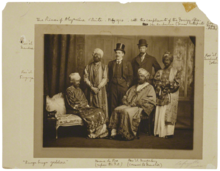
After the death of their father and Virginia's second nervous breakdown, Vanessa and Adrian sold 22 Hyde Park Gate and bought a house at 46 Gordon Square in Bloomsbury.
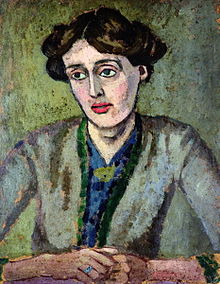
Woolf came to know Lytton Strachey, Clive Bell, Rupert Brooke, Saxon Sydney-Turner, Duncan Grant, Leonard Woolf, John Maynard Keynes, David Garnett, and Roger Fry, who together formed the nucleus of the intellectual circle of writers and artists known as the Bloomsbury Group. Several members of the group attained notoriety in 1910 with the Dreadnought hoax, which Virginia participated in disguised as a male Abyssinian royal. Her complete 1940 talk on the hoax was discovered and is published in the memoirs collected in the expanded edition of The Platform of Time (2008). In 1907 Vanessa married Clive Bell, and the couple's interest in avant garde art would have an important influence on Woolf's development as an author.
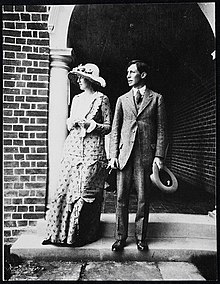
Virginia Stephen married the writer Leonard Woolf on 10 August 1912. Despite his low material status (Woolf referring to Leonard during their engagement as a "penniless Jew") the couple shared a close bond. Indeed, in 1937, Woolf wrote in her diary: "Love-making—after 25 years can't bear to be separate ... you see it is enormous pleasure being wanted: a wife. And our marriage so complete." The two also collaborated professionally, in 1917 founding the Hogarth Press, which subsequently published Virginia's novels along with works by T. S. Eliot, Laurens van der Post, and others. The Press also commissioned works by contemporary artists, including Dora Carrington and Vanessa Bell. Woolf believed that to break free of a patriarchal society that women writers needed a "room of their own" to develop and often fantasised about an "Outsider's Society" where women writers would create a virtual private space for themselves via their writings to develop a feminist critique of society. Through Woolf never created the "Outsider's society", the Hogarth Press was the closest approximation as Woolf chose to publish books by writers that took unconventional points of view to form a reading community. Until 1930, Woolf often helped her husband print the Hogarth books as the money for employees was not there. Both the Woolfs were internationalists and pacifists who believed that promoting understanding between peoples was the best way to avoid another world war and chose quite consciously to publish works by foreign authors that the British reading public were unaware of. The first non-British author to be published was the Soviet writer Maxim Gorky's book Reminiscences of Leo Nikolaiovich Tolstoy in 1920 dealing with his friendship with Count Leo Tolstoy.

Leonard and Virginia Woolf lived at 17 The Green Richmond starting from October 1914. Leonard talks about it in his autobiography called "Beginning again" (1964). In early March 1915 the couple moved to nearby Hogarth House, Paradise Road.

In 1919, the Woolfs purchased the Round House in Pipe Passage, Lewes. The same year they discovered Monk’s House in nearby Rodmell, which both she and Leonard favored because of its orchard and garden. She then bought Monk’s House and sold the Round House.
The ethos of the Bloomsbury group encouraged a liberal approach to sexuality, and in 1922 she met the writer and gardener Vita Sackville-West, wife of Harold Nicolson. At the time, Sackville-West was the more successful writer both commercially and critically and it was not after Woolf's death she was considered the better writer. After a tentative start, they began a sexual relationship, which, according to Sackville-West in a letter to her husband dated 17 August 1926, was only twice consummated. However, Virginia's intimacy with Vita seems to have continued into the early 1930s.
Sackville-West worked tirelessly to lift up Woolf's self-esteem, encouraging her not to view herself as a quasi-reclusive inclined to sickness who should hide herself away from the world, but rather offered praise for her liveliness and sense of wit, her health, her intelligence and achievements as a writer. Sackville-West led Woolf to reappraise herself, developing a more positive self-image, and the feeling that her writings were the products of her strengths rather than her weakness. Starting at the age of 15, Woolf had believed the diagnosis by her father and his doctor that reading and writing were deleterious on her nervous condition, requiring a regime of physical labor like gardening to prevent a total nervous collapse, leading Woolf to spend much time obsessively engaging in physical labor. Sackville-West was the first to argue to Woolf she had been misdiagnosed, and it was far better to engage in reading and writing to calm her nerves, advice that was taken. Under the influence of Sackville-West, Woolf learned to deal with her nervous aliments by switching from various forms of intellectual activities, like reading, writing and book reviews, instead of spending her time in physical activities that sapped her strength and worsened her nerves. Sackville-West chose the financially struggling Hogarth Press to be her publisher in order to assist the Woolfs financially. Seducers in Ecuador, the first of the novels by Sackville-West published by Hogarth was not a success, selling only 1, 500 copies in its first year, but the next Sackville-West novel to be published by Hogarth, The Edwardians was a bestseller that sold 30, 000 copies in its six months. Sackville-West's novels, through not typical of the Hogarth Press, saved Hogarth, taking Hogarth from the red into the black. However, Woolf was not always appreciative of the fact that it was Sackville-West's books that were kept the Hogarth Press profitable, writing dismissively in 1933 of Sackville-West "servant girl" novels. In turn, the financial security allowed by the good sales figures of Sackville-West's novels allowed Woolf to engage in more experimental work such as The Waves as Woolf had to be cautious when she depended upon Hogarth entirely for her income.
In 1928, Woolf presented Sackville-West with Orlando, a fantastical biography in which the eponymous hero's life spans three centuries and both sexes. Nigel Nicolson, Vita Sackville-West's son, wrote, "The effect of Vita on Virginia is all contained in Orlando, the longest and most charming love letter in literature, in which she explores Vita, weaves her in and out of the centuries, tosses her from one sex to the other, plays with her, dresses her in furs, lace and emeralds, teases her, flirts with her, drops a veil of mist around her." After their affair ended, the two women remained friends until Woolf's death in 1941. Virginia Woolf also remained close to her surviving siblings, Adrian and Vanessa; Thoby had died of typhoid fever at the age of 26.
Death
After completing the manuscript of her last (posthumously published) novel, Between the Acts, Woolf fell into a depression similar to that which she had earlier experienced. The onset of World War II, the destruction of her London home during the Blitz, and the cool reception given to her biography of her late friend Roger Fry all worsened her condition until she was unable to work. On 28 March 1941, Woolf drowned herself by filling her overcoat pockets with stones and walking into the River Ouse near her home. Woolf's body was not found until 18 April. Her husband buried her cremated remains beneath an elm tree in the garden of Monk's House, their home in Rodmell, Sussex.
In her suicide note, addressed to her husband, she wrote:

Dearest, I feel certain that I am going mad again. I feel we can't go through another of those terrible times. And I shan't recover this time. I begin to hear voices, and I can't concentrate. So I am doing what seems the best thing to do. You have given me the greatest possible happiness. You have been in every way all that anyone could be. I don't think two people could have been happier till this terrible disease came. I can't fight any longer. I know that I am spoiling your life, that without me you could work. And you will I know. You see I can't even write this properly. I can't read. What I want to say is I owe all the happiness of my life to you. You have been entirely patient with me and incredibly good. I want to say that—everybody knows it. If anybody could have saved me it would have been you. Everything has gone from me but the certainty of your goodness. I can't go on spoiling your life any longer. I don't think two people could have been happier than we have been. V.
Mental illness
Much examination has been made of Woolf's mental illness, described as a "manic-depressive illness" in Thomas Caramagno's 1992 book, The Flight of the Mind: Virginia Woolf's Art and Manic-Depressive Illness, in which he also warns against the "neurotic-genius" way of looking at mental illness, where people rationalise that creativity is somehow born of mental illness. In a book by Stephen Trombley, Woolf is described as having a confrontational relationship with her doctors, and possibly being a woman who is a "victim of male medicine", referring to the contemporary relative lack of understanding about mental illness. Thomas Szasz's book My Madness Saved Me: The Madness and Marriage of Virginia Woolf was published in 2006.
Irene Coates's book Who's Afraid of Leonard Woolf: A Case for the Sanity of Virginia Woolf holds that Leonard Woolf's treatment of his wife encouraged her ill health and ultimately was responsible for her death. Though extensively researched from the feminist perspective, this view is not accepted by Leonard's family and some critics. Victoria Glendinning's book Leonard Woolf: A Biography argues that Leonard Woolf was not only supportive of his wife but enabled her to live as long as she did by providing her with the life and atmosphere she needed to live and write. Virginia's own diaries support this view of the Woolfs' marriage.
Woolf's fiction is also studied for its insight into shell shock, war, class and modern British society.
Works

Woolf is a major novelist and one of the pioneers among modernist writers using stream of consciousness as a narrative device, alongside her contemporaries Marcel Proust, Dorothy Richardson and James Joyce. Woolf's reputation declined sharply after World War II, but her importance was re-established with the growth of feminist criticism in the 1970s.
She began writing professionally in 1900. The first of her writings to be accepted for publication, "Haworth, November 1904", a journalistic account of a visit to the Brontë family home at Haworth, was published anonymously in a women's supplement to a clerical journal, The Guardian in December 1904. From 1905 she wrote for The Times Literary Supplement.
Her first novel, The Voyage Out, was published in 1915 by her half-brother's imprint, Gerald Duckworth and Company Ltd. This novel was originally titled Melymbrosia, but Woolf repeatedly changed the draft. An earlier version of The Voyage Out has been reconstructed by Woolf scholar Louise DeSalvo and is now available to the public under the intended title. DeSalvo argues that many of the changes Woolf made in the text were in response to changes in her own life.
Woolf went on to publish novels and essays as a public intellectual to both critical and popular acclaim. Much of her work was self-published through the Hogarth Press.
"Virginia Woolf's peculiarities as a fiction writer have tended to obscure her central strength: she is arguably the major lyrical novelist in the English language. Her novels are highly experimental: a narrative, frequently uneventful and commonplace, is refracted—and sometimes almost dissolved—in the characters' receptive consciousness. Intense lyricism and stylistic virtuosity fuse to create a world overabundant with auditory and visual impressions".
"The intensity of Virginia Woolf's poetic vision elevates the ordinary, sometimes banal settings"—often wartime environments—"of most of her novels". "For example, Mrs Dalloway (1925) centres on the efforts of Clarissa Dalloway, a middle-aged society woman, to organise a party, even as her life is paralleled with that of Septimus Warren Smith, a working-class veteran who has returned from the First World War bearing deep psychological scars",
"To the Lighthouse (1927) is set on two days ten years apart. The plot centres on the Ramsay family's anticipation of and reflection upon a visit to a lighthouse and the connected familial tensions. One of the primary themes of the novel is the struggle in the creative process that beset painter Lily Briscoe while she struggles to paint in the midst of the family drama. The novel is also a meditation upon the lives of a nation's inhabitants in the midst of war, and of the people left behind." It also explores the passage of time, and how women are forced by society to allow men to take emotional strength from them.
Orlando (1928) is one of Virginia Woolf's lightest novels. A parodic biography of a young nobleman who lives for three centuries without ageing much past thirty (but who does abruptly turn into a woman), the book is in part a portrait of Woolf's lover Vita Sackville-West. It was meant to console Vita for the loss of her ancestral home, Knole House, though it is also a satirical treatment of Vita and her work. In Orlando, the techniques of historical biographers are being ridiculed; the character of a pompous biographer is being assumed in order for it to be mocked.
"The Waves (1931) presents a group of six friends whose reflections, which are closer to recitatives than to interior monologues proper, create a wave-like atmosphere that is more akin to a prose poem than to a plot-centred novel".
Flush: A Biography (1933) is a part-fiction, part-biography of the cocker spaniel owned by Victorian poet Elizabeth Barrett Browning. The book is written from the dog's point of view. Woolf was inspired to write this book from the success of the Rudolf Besier play The Barretts of Wimpole Street. In the play, Flush is on stage for much of the action. The play was produced for the first time in 1932 by the actress Katharine Cornell.
"Her last work, Between the Acts (1941), sums up and magnifies Woolf's chief preoccupations: the transformation of life through art, sexual ambivalence, and meditation on the themes of flux of time and life, presented simultaneously as corrosion and rejuvenation—all set in a highly imaginative and symbolic narrative encompassing almost all of English history." This book is the most lyrical of all her works, not only in feeling but in style, being chiefly written in verse. While Woolf's work can be understood as consistently in dialogue with the Bloomsbury group, particularly its tendency (informed by G. E. Moore, among others) towards doctrinaire rationalism, it is not a simple recapitulation of the coterie's ideals.
Woolf's works have been translated into over 50 languages by writers such as Jorge Luis Borges and Marguerite Yourcenar.
Influences on Woolf

A major influence on Woolf from 1912 onward was Russian literature as Woolf adopted the aesthetic conventions of Russian literature. The style of Fyodor Dostoyevsky with his depiction of a fluid mind in operation helped to influence Woolf's writings about a "discontinuous writing process", through Woolf objected to Doestoyevsky's obsession with "psychological extremity" and the "tumultuous flux of emotions" in his characters together with his right-wing, monarchist politics as Dostoyevsky was an ardent supporter of the autocracy of Imperial Russia. In contrast to her objections to Dostoyevsky's "exaggerated emotional pitch", Woolf found much to admire in the work of Anton Chekhov and Leo Tolstoy. Woolf admired Chekhov for his stories of ordinary people living their lives, doing banal things and plots that had no neat endings. From Tolstoy, Woolf drew lessons about how a novelist should depict a character's psychological state and the interior tension within. From Ivan Turgenev, Woolf drew the lessons that there are multiple "I's" when writing a novel, and the novelist needed to balance those the multiple versions of himself/herself to balance the "mundane facts" of a story vs. the writer's overreaching vision, which required a "total passion" for art.
Another influence on Woolf was the American writer Henry David Thoreau, with Woolf writing in a 1917 essay that her aim as a writer was to follow Thoreau by capturing "the moment, to burn always with this hard, gem-like flame" while praising Thoreau for his statement "The millions are awake enough for physical labor, but only one in hundreds of millions is awake enough to a poetic or divine life. To be awake is to be alive". Woolf praised Theoreau for his "simplicity" in finding "a way for settling free the delicate and complicated machinery of the soul". Like Thoreau, Woolf believed that it was silence that set the mind free to really contemplate and understand the world. Both authors believed in a certain transcendental, mystical approach to life and writing, where even banal things could be capable of generating deep emotions if one had enough silence and the presence of mind to appreciate them. Woolf and Thoreau were both concerned with the difficulty of human relationships in the modern age.
Other notable influences include: William Shakespeare, George Eliot, Leo Tolstoy, Marcel Proust, Anton Chekhov, Emily Brontë, Daniel Defoe, James Joyce, E. M. Forster.
Attitudes toward Judaism, Christianity and fascism
Though happily married to a Jewish man, Woolf often wrote of Jewish characters in stereotypical archetypes and generalisations, including describing some of her Jewish characters as physically repulsive and dirty. For example, while traveling on a cruise to Portugal she protests at finding "a great many Portuguese Jews on board, and other repulsive objects, but we keep clear of them". Furthermore, she wrote in her diary: "I do not like the Jewish voice; I do not like the Jewish laugh." In a 1930 letter to the composer Ethel Smyth, quoted in Nigel Nicolson's biography Virginia Woolf, she recollects her boasts of Leonard's Jewishness confirming her snobbish tendencies, "How I hated marrying a Jew—What a snob I was, for they have immense vitality."
In another letter to Smyth, Woolf gives a scathing denunciation of Christianity, seeing it as self-righteous "egotism" and stating "my Jew has more religion in one toenail—more human love, in one hair."
Woolf and her husband Leonard hated and feared 1930s fascism with its antisemitism. Her 1938 book Three Guineas was an indictment of fascism.
Modern scholarship and interpretations

Though at least one biography of Virginia Woolf appeared in her lifetime, the first authoritative study of her life was published in 1972 by her nephew Quentin Bell. Hermione Lee's 1996 biography Virginia Woolf provides a thorough and authoritative examination of Woolf's life and work. In 2001 Louise DeSalvo and Mitchell A. Leaska edited The Letters of Vita Sackville-West and Virginia Woolf. Julia Briggs's Virginia Woolf: An Inner Life (2005) focuses on Woolf's writing, including her novels and her commentary on the creative process, to illuminate her life.
Historical feminism
"Recently, studies of Virginia Woolf have focused on feminist and lesbian themes in her work, such as in the 1997 collection of critical essays, Virginia Woolf: Lesbian Readings, edited by Eileen Barrett and Patricia Cramer."
In 1928, Virginia Woolf took a grassroots approach to informing and inspiring feminism. She addressed undergraduate women at the ODTAA Society at Girton College, Cambridge and the Arts Society at Newnham College with two papers that eventually became A Room of One’s Own. Woolf's best-known nonfiction works, A Room of One's Own (1929) and Three Guineas (1938), examine the difficulties that female writers and intellectuals faced because men held disproportionate legal and economic power, as well as the future of women in education and society, as the societal effects of industrialization and birth control had not yet fully been realized. In The Second Sex (1949), Simone de Beauvoir counts, of all women who ever lived, only three female writers—Emily Brontë, Woolf and "sometimes" Katherine Mansfield— have explored "the given."
Legacy

Michael Cunningham's 1998 Pulitzer Prize-winning novel The Hours focused on three generations of women affected by Woolf's novel Mrs Dalloway. In 2002, a film version of the novel was released starring Nicole Kidman as Woolf, a role for which she won the 2002 Academy Award for Best Actress. The film also starred Julianne Moore and Meryl Streep and featured an award-winning score by the American composer Philip Glass.
Susan Sellers' novel Vanessa and Virginia (2008) explores the close sibling relationship between Woolf and her sister, Vanessa Bell. It was adapted for the stage by Elizabeth Wright in 2010 and first performed by Moving Stories Theatre Company.
Priya Parmar's 2014 novel Vanessa and Her Sister also examined the Stephen sisters' relationship during the early years of their association with what became known as the Bloomsbury Group.
Virginia is portrayed by both Lydia Leonard and Catherine McCormack in the BBC's three-part drama series Life in Squares.
The artwork The Dinner Party features a place setting for Woolf.
An exhibition on Virginia Woolf was held at the National Portrait Gallery from July to October 2014.
Who's Afraid of Virginia Woolf? is a 1962 play by Edward Albee. It examines the structure of the marriage of an American middle-aged academic couple, Martha and George. Mike Nichols released a movie version in 1966, starring Elizabeth Taylor and Richard Burton. Taylor won the 1966 Academy Award for Best Actress for the role.
Me! I'm Afraid of Virginia Woolf, a 1978 TV play, references the title of the Edward Albee play and features an English literature teacher who has a poster of her. It was written by Alan Bennett and directed by Stephen Frears.
Influenced: Margaret Atwood, Michael Cunningham, Gabriel García Márquez, Toni Morrison
 Aquarius
Aquarius